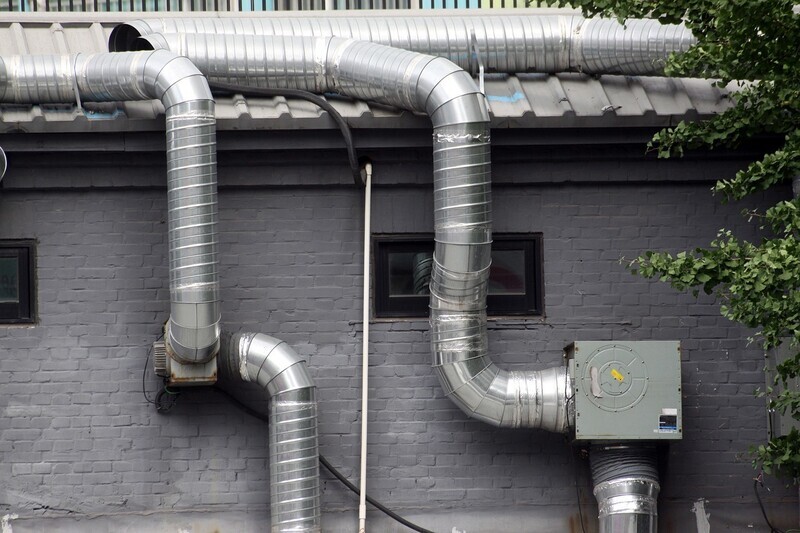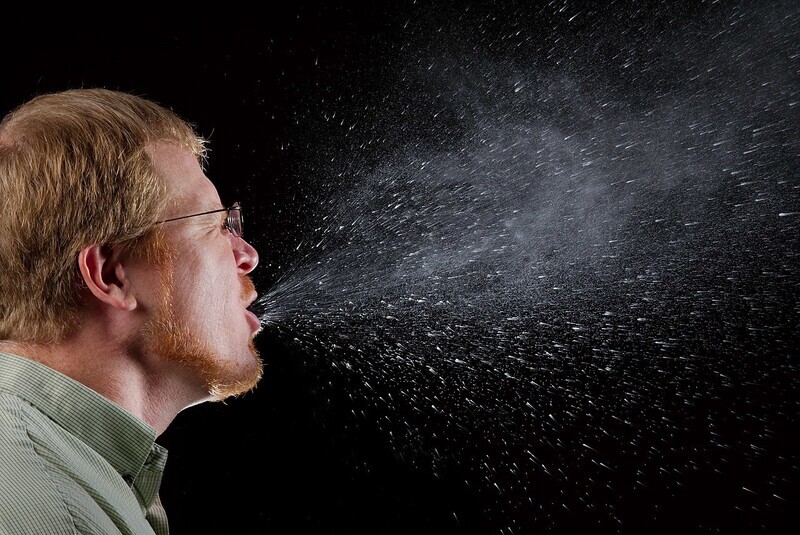hankyoreh
Links to other country sites 다른 나라 사이트 링크
COVID-19 is transmitted by air, studies show

Whether the COVID-19 virus is transmitted by air has remained the subject of debate since the pandemic first erupted.
When the virus began spreading around the world early last year, the World Health Organization (WHO) and public health authorities and experts in individual countries based their social distancing guidelines on the premise that it was spread through droplets.
Scholars define droplets as particles larger than 5 micrometers (one-thousandth of a millimeter, μm) in size, while smaller particles are categorized as aerosols.
Droplets expelled from the body through coughing, sneezing and breathing are known to fall to the ground within seconds and typically do not travel for distances larger than two meters. The selection of distances of 1.8 or 2 meters for social distancing has been based on this.

As more and more cases emerged of people becoming infected despite being some distance from the person transmitting the virus, the possibility of airborne transmission began to attract greater attention. Yet, the guidelines have continued to be based on the previous standard of transmission through droplets.
A systematic review conducted in March 2021 with support from the WHO failed to reach a clear conclusion on the airborne transmission question, citing inadequate samples. The US Centers for Disease Control and Prevention added a warning last October stating that airborne transmission may occur in “some infections,” but it went on to say that transmission through respiratory droplets in situations of face-to-face contact represented the most common route.
But several international journals have recently published arguments for basing public health measures on the premise that airborne transmission is actually the dominant route.
A research team led by Oxford professor of primary health sciences Trisha Greenhalgh and including five other researchers from the UK, the US and Canada recently published an article titled “Ten scientific reasons in support of airborne transmission of SARS-CoV-2,” based on its examination of over 20 selected papers published since last year.
Shared in the form of a brief “comment” in the international medical journal The Lancet, it argues that consistent and powerful evidence suggests the COVID-19 virus is transmitted mainly by air.

The first piece of evidence cited by the researchers concerned superspreading events.
“Detailed analyses of human behaviours and interactions, room sizes, ventilation, and other variables in choir concerts, cruise ships, slaughterhouses, care homes, and correctional facilities, among other settings, have shown patterns [. . .] consistent with airborne spread of SARS-CoV-2 that cannot be adequately explained by droplets or fomites,” the article said.
“The high incidence of such events strongly suggests the dominance of aerosol transmission,” it continued.
Second, they noted cases of COVID-19 transmission that occurred between different rooms in quarantine hotels, despite the individuals never encountering each other directly.
Third, they observed that cases of transmission by asymptomatic or presymptomatic individuals who were neither coughing nor sneezing accounted for anywhere from one-third to 60 percent of COVID-19 transmission throughout the world.
The researchers also said that the airborne transmission conclusion was supported by the fact that examinations of actual particles expelled from people’s mouths when they speak show them producing thousands of aerosol particles, but only very few large saliva particles.

Additional factor cited as bases for concluding that the COVID-19 virus is transmitted by air include the higher prevalence of indoor rather than outdoor transmission and the decrease in transmission rates when indoor facilities are ventilated; the occurrence of infections even in hospital facilities that focus on droplet-based transmission prevention with their personal protective equipment and other precautions; and COVID-19 infections among animals whose cages were connected by air ducts.
The researchers further pointed to the detection of the virus in air filters and building ducts in hospitals with COVID-19 patients. “[S]uch locations could be reached only by aerosols,” they noted.
Another important piece of evidence they cited was the isolation of transmissible virus from the air in hospital rooms used by COVID-19 patients and vehicles in which infected individuals were riding.
Laboratory experimentation has shown that the COVID-19 virus can remain transmissible for up to three hours in the air, with a half-life of 1.1 hours.
Finally, the researchers noted the absence of studies showing consistent and strong evidence to refute the airborne transmission hypothesis or evidence to support other dominant transmission routes such as respiratory droplets.
Additionally, the researchers cited experimental evidence as pointing to a need to move beyond the dogmatic insistence on the “particle size of 5 μm [as a standard to distinguish] between aerosols and droplets, instead of the correct boundary of 100 μm.”
Shifting focus from sterilization to ventilationIn the article, the researchers wrote, “In conclusion, we propose that it is a scientific error to use lack of direct evidence of SARS-CoV-2 in some air samples to cast doubt on airborne transmission while overlooking the quality and strength of the overall evidence base.”
“Although other routes can contribute, we believe that the airborne route is likely to be dominant,” they continued, urging the public health community to take corresponding action “without further delay.”
The British Medical Journal also published an editorial on April 14 under the title “Covid-19 has redefined airborne transmission.”
“Essentially, if you can inhale particles — regardless of their size or name — you are breathing in aerosols,” the editorial said, stressing the importance of ventilation and mask quality.
The editorial also suggested that improvements in indoor air quality through ventilation could also bring about benefits in terms of other respiratory virus infections, allergies and sick building syndrome.
In a Feb. 2 editorial, the international science journal Nature wrote, “A year into the pandemic, the evidence is now clear. The coronavirus SARS-CoV-2 is transmitted predominantly through the air.”
In the editorial, it urged world public health authorities to develop new guidelines based on the latest scientific understanding and to focus their measures more on aerosols than on surface sterilization, including the encouragement of improved ventilation.
By Kwak No-pil, senior staff writer
Please direct comments or questions to [english@hani.co.kr]

Editorial・opinion
![[Editorial] Perilous stakes of Trump’s rhetoric around US troop pullout from Korea [Editorial] Perilous stakes of Trump’s rhetoric around US troop pullout from Korea](https://flexible.img.hani.co.kr/flexible/normal/500/300/imgdb/original/2024/0509/221715238827911.jpg) [Editorial] Perilous stakes of Trump’s rhetoric around US troop pullout from Korea
[Editorial] Perilous stakes of Trump’s rhetoric around US troop pullout from Korea![[Guest essay] Preventing Korean Peninsula from becoming front line of new cold war [Guest essay] Preventing Korean Peninsula from becoming front line of new cold war](https://flexible.img.hani.co.kr/flexible/normal/500/300/imgdb/original/2024/0507/7217150679227807.jpg) [Guest essay] Preventing Korean Peninsula from becoming front line of new cold war
[Guest essay] Preventing Korean Peninsula from becoming front line of new cold war- [Column] The state is back — but is it in business?
- [Column] Life on our Trisolaris
- [Editorial] Penalties for airing allegations against Korea’s first lady endanger free press
- [Editorial] Yoon must halt procurement of SM-3 interceptor missiles
- [Guest essay] Maybe Korea’s rapid population decline is an opportunity, not a crisis
- [Column] Can Yoon steer diplomacy with Russia, China back on track?
- [Column] Season 2 of special prosecutor probe may be coming to Korea soon
- [Column] Park Geun-hye déjà vu in Yoon Suk-yeol
Most viewed articles
- 1Nuclear South Korea? The hidden implication of hints at US troop withdrawal
- 2[Editorial] Perilous stakes of Trump’s rhetoric around US troop pullout from Korea
- 3‘Free Palestine!’: Anti-war protest wave comes to Korean campuses
- 4Korea likely to shave off 1 trillion won from Indonesia’s KF-21 contribution price tag
- 5In Yoon’s Korea, a government ‘of, by and for prosecutors,’ says civic group
- 6With Naver’s inside director at Line gone, buyout negotiations appear to be well underway
- 7[Photo] ‘End the genocide in Gaza’: Students in Korea join global anti-war protest wave
- 8Seoul getting its first-ever vertical farm
- 9‘We must say no’: Seoul defense chief on Korean, USFK involvement in hypothetical Taiwan crisis
- 10Behind-the-times gender change regulations leave trans Koreans in the lurch